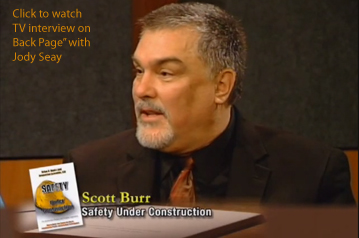Category Archives: Accident free environments
Scott and Dayna Interviewed on TV
Dayna and Scott were invited on TV show “Back Page” with interviewer extraordinaire Jody Seay.
What is Back Page? In 2004, Jody came up with the big idea of having a TV program wherein she got to interview Oregon authors. The show is called BACK PAGE because sometimes, when you flip to the back page of a book, you can find out some scoop about the author, and maybe even a little about the motivation behind the story. Jody sits down each month and tapes interviews with some of the most interesting people and finds out more than they probably thought they were going to tell – not only about what they have written, but what they are working on now and, most importantly, why they do what they do at all!
Jody is a great interviewer and we were both excited and honored to be on her show. Click here to watch our episode on BACK PAGE talking about “Safety Under Construction”.
In fact, once she got us talking, she could hardly shut us up – and that has never happened before according to her producer. Watch this lively interview, learn about construction safety, and we hope you have fun. We certainly did. Thank you, Jody!
Why Safety Professionals have to go beyond being the Squeaky Wheel
Joseph Wesley a safety professional wrote a comment in response to Sandy Smith’s article, “Former President of Chemical Company Sentenced for Federal Crimes Related to Employee Deaths” on ehstoday.com
Mr. Westley said, “As Safety Professionals we have to be the squeaky wheel. We have understand how to communicate the consequences of bad /unsafe actions to the next level leadership. The people that follow us are counting on it.”
And he is absolutely correct, but that is just the first step in a countermeasure for safety.
In our safety book co-authors Brion K. Hanks and Scott Burr join me in saying, “In regards to the unspoken cold war between production and safety, we have noticed that some industry leaders are expending enormous amounts of activity with relatively minor new achievement. Safety as a discipline needs an upgrade and a reboot. The result of this delusion (that activity equals achievement) is that people are routinely hurt and killed on the job…
…One of the reasons we succumb to trading-off safety for schedule or profits is because management and ‘designers’ throw problems over the wall instead of taking full accountability for what they create. All of this ‘tossing off of responsibility’ lands squarely on the worker in the field in bad weather with pressures and dangers all around. This is the worst place to try and solve problems that should have been solved upstream….” Safety needs to be more systematic.
Here’s one more point. Safety professional often rely on OSHA or other safety inspections as the great countermeasure to unsafe situations. But this needs to change. “Inspections can detect mistakes only after they have been generated (or when they are in the process of being made). Inspections are not predictive. They are not systematically integrated into decision-making and they are not scientific. They catch infractions; but don’t stop hazards from being created in the first place. They are better than nothing, but mistakes will be made because there are not enough inspectors to be everywhere at all times and no human can be 100-percent vigilant… Inspections will not assure that your workers are safe. In fact, inspections are the lowest form of assurance that can be provided. In order for inspections to be effective, they would have to be constant, omnipresent, vigilant, and redundant. But they are not constant; they cannot be omnipresent; and it is too costly to be 100-percent vigilant and redundant… Because inspections are countermeasures they are an ongoing cost. However, if you generate real safety solutions this savings is the money that you get back from that investment. If you develop these solutions it helps your company be more efficient and will keep your workers safer.”
Along the same lines, speaking up, “whistle blowing”, sounding off about safety issues is important. In fact, it’s vital! And I applaud you because you have the courage of a lion and your heart is in the correct place. Having said that, it is a tiny part of what safety professionals can be doing today. Most people are entrenched in the belief that safety is in the way of production and that is simply not true. Industries need to completely change their mindset. In fact, safety can become THE KEY (the leverage point) for greater construction profits and schedule performance.
Go forth and be safe and productive all at the same time.

